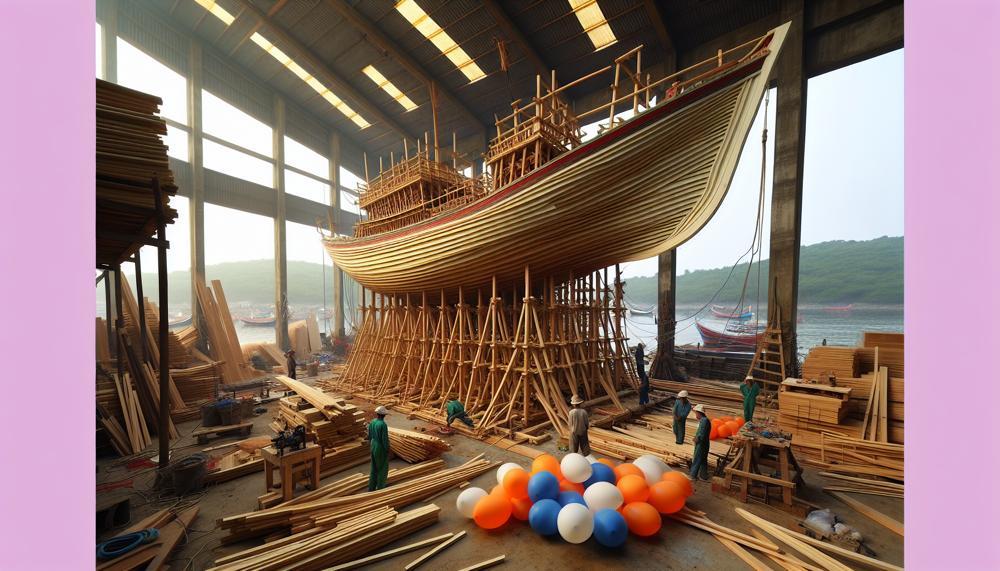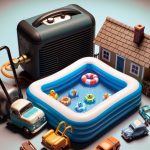Imagine gliding across the ocean, the salty breeze caressing your skin and the endless horizon stretching before you. It’s a dream that many of us share, but building a boat may seem like an impossible feat. Fear not, for we are here to guide you through the process and help you create a buoyant and sturdy vessel that can weather any storm.
In this blog post, we will take you on a journey of building a boat from scratch – from selecting the perfect wood to adding essential flotation devices. With our expert tips and step-by-step instructions, you’ll have all the tools you need to craft your own seaworthy masterpiece. Get ready to embark on an exciting adventure as we cover key points such as:
- Choosing the ideal wood for your boat’s frame, ensuring strength and durability
- Utilizing marine-grade plywood for added resilience against harsh conditions
- Properly sealing and waterproofing your boat’s exterior for long-lasting protection
- Enhancing buoyancy with strategically placed flotation devices
- Assembling and reinforcing the structure of your boat for maximum stability
So let’s dive in and learn how to build a boat that is both functional and beautiful.
With determination and perseverance, you’ll soon be sailing off into the sunset in a vessel crafted by your own hands. Let’s set sail together.
How To Make A Boat That Floats And Holds Weight?
Contents
- 1 How To Make A Boat That Floats And Holds Weight?
- 2 Understanding the Basics of Buoyancy
- 3 Materials Needed for Making a Floating Boat
- 4 Step-by-Step Guide on Making a Floating Boat
- 5 Testing and Adjusting for Optimal Floatation
- 6 Utilizing Coins or Pennies for Weight Capacity
- 7 Enhancing Your Floating Boat with Creative Additions
- 8 Conclusion
When constructing a boat that can float and hold weight, there are several crucial factors to consider.
These include the boat’s design and shape, the materials used in its construction, the distribution of weight within the boat, and the boat’s load capacity.
These elements work in harmony to create a well-proportioned and robust vessel that can safely navigate the waters with added weight.
By thoughtfully considering these factors, one can build a stable and dependable boat that will provide an enjoyable experience on the water for many years.
The design and shape of a boat play a crucial role in how it performs on the water. A sleek and streamlined design can reduce drag and improve stability, making it easier for the boat to float and maneuver with added weight.
Additionally, the materials used in construction must be carefully selected to ensure they are strong enough to support the added weight without compromising the boat’s structural integrity.
Another factor to consider is the distribution of weight within the boat. Placing too much weight on one side can cause instability and potentially lead to capsizing. It’s essential to distribute weight evenly throughout the boat to maintain balance and stability on the water.

The boat’s load capacity is also a critical consideration. Each boat has a maximum weight limit, beyond which it cannot safely navigate. It is essential to know this limit and not exceed it when adding weight to the boat.
Understanding the Basics of Buoyancy
Buoyancy is the upward force exerted by a liquid, such as water, on an object that is immersed in it.
This force opposes the weight of the object and enables it to float or remain suspended in the liquid. In the world of boating, buoyancy plays a vital role in keeping vessels afloat and able to handle additional weight without sinking.
There are several factors that affect buoyancy, including displacement, hull design, weight distribution, and load capacity. The shape and size of a boat’s hull determine how much water it can displace, which in turn affects its buoyancy.
Different types of hull designs, such as displacement and planning hulls, impact how a boat sits on the surface of the water and its stability at different speeds.
Proper weight distribution is also crucial for maintaining optimal buoyancy. A well-balanced boat will evenly distribute the weight throughout its hull, allowing it to sit evenly on the surface of the water without tipping over.
Additionally, adhering to weight limits and correctly placing ballast can also affect a boat’s buoyancy and stability.
Materials Needed for Making a Floating Boat
When it comes to creating a floating boat, there are several key materials that are essential to have on hand. These include wood, fiberglass, aluminum, plastic, and inflatable materials. Each of these materials has its own unique properties and strength, but when used correctly, they can all work together to create a sturdy and buoyant boat.
However, it is important to note that the quality of materials used is crucial in ensuring the safety and durability of the boat. Using low-quality materials or cutting corners in the construction process can compromise the integrity of the boat and put its passengers at risk.
To create a truly reliable and long-lasting floating boat, it is recommended to use high-quality materials from trusted sources. This will not only result in a safer vessel but also help extend its lifespan and save on future repair costs.
In addition to using high-quality materials, it is also essential to properly maintain and care for the boat to ensure its continued buoyancy and safety on the water. This includes regular inspections, repairs when necessary, and following proper storage guidelines when not in use.
By utilizing top-quality materials and proper maintenance techniques, you can rest assured that your floating boat will provide endless hours of safe and enjoyable fun on the water.
Step-by-Step Guide on Making a Floating Boat
Making a floating boat that can hold weight is a relatively simple task. All you need are some basic materials and tools, along with a little creativity and determination. Follow this step-by-step guide to create your own floating boat:
- Gather the necessary materials: You will need wood or foam sheets, PVC pipes or dowels, waterproof sealant, and basic tools like a saw, drill, and measuring tape.
- Cut the base of the boat: Begin by cutting your chosen material into a rectangular shape. This will serve as the foundation of your boat. The size of the base can vary depending on your desired boat size and weight capacity.
- Construct the sides of the boat: Measure and cut the PVC pipes or dowels to match the length and width of your base. Use waterproof sealant to securely attach them to the base.
- Reinforce the frame: To ensure stability and prevent your boat from buckling under weight, add horizontal supports between the sides of the boat. These supports should connect to both the base and sides.
- Make it waterproof: Apply waterproof sealant to all joints and connections of the boat to prevent water from seeping in. For added protection, you can also cover the base with a layer of waterproof fabric or tarp.
By following these steps and understanding the principles of buoyancy, even those without prior experience can successfully create a floating boat that can hold weight. However, it is essential to use high-quality materials and reinforce the structure for maximum strength and safety.
Testing and Adjusting for Optimal Floatation
When experimenting and fine-tuning a vessel for ideal buoyancy and weight distribution, it is imperative to take into account factors such as boat structure, weight limit, weight balance, freeboard, water conditions, and tilt.
These variables can greatly affect the vessel’s steadiness, maneuverability, and overall security. Thorough testing and adjustments are essential to guarantee the vessel can efficiently navigate varying water conditions and cargos.
In addition to the aforementioned factors, there are other critical elements to consider when optimizing a boat’s floatation. For example, the boat’s shape and design play a significant role in its stability and handling.
A wider hull will provide more stability in rough waters, while a narrower hull is better suited for calm conditions. The load capacity of the boat is also crucial to consider. Overloading a boat can cause it to sit too low in the water, making it less stable and more prone to capsizing.
Furthermore, the distribution of weight on a boat can greatly impact its performance. Placing too much weight on one side of the boat can cause it to tilt and become unbalanced, affecting its ability to navigate through the water.
This is where trim comes into play; adjusting the trim of a boat can help distribute weight evenly and improve its handling.
Freeboard is another essential factor that should not be overlooked. It refers to the distance between the waterline and the deck of a boat. The higher the freeboard, the better the boat will handle rough waters as it provides more buoyancy and prevents water from entering the vessel.
Utilizing Coins or Pennies for Weight Capacity
The Archimedes principle is a powerful tool for increasing the weight capacity of a boat. By utilizing coins or pennies, which are denser than water, one can enhance the buoyancy of the vessel and achieve better weight distribution. This technique provides added flexibility in adjusting weight capacity and can be particularly useful for smaller boats such as kayaks or canoes that have a narrower base and are more prone to tipping over.
Adding coins or pennies to a boat may seem like a simple solution, but it is backed by science and can significantly improve the performance of the vessel. The principle states that an object immersed in a fluid will experience an upward force equal to the weight of the fluid it displaces. By increasing the density of the boat with coins or pennies, it can float higher and carry more weight.
Moreover, strategically placing these coins or pennies in different areas of the boat can also help achieve better balance and stability. This allows for a smoother and more enjoyable experience on the water, as well as increased confidence in the boat’s capabilities.
When utilizing this method, it is essential to consider the weight distribution carefully. Placing too much weight on one side of the boat can result in instability and even cause it to capsize. Therefore, it is crucial to distribute the coins or pennies evenly throughout the vessel.
Enhancing Your Floating Boat with Creative Additions
There are numerous ways to upgrade your boat’s floating and weight-holding abilities. These enhancements vary from simple flotation tools to more complex systems that require installation.
Below are some of the most effective and innovative ways to improve your boat’s ability to stay afloat and carry more weight:
| Upgrade | Description | Advantages |
| Flotation devices | Air-filled tubes, foam blocks, or inflatable pontoons attached to the sides or bottom of the boat. | Increases buoyancy, maintains stability in rough waters. |
| Trim tab system | Small metal plates attached to the bottom of the boat that can be adjusted to change its angle in the water. | Allows for better weight distribution and improved floating capabilities. |
| Ballast system | Adds weight to the boat through means such as water tanks, lead weights, or bags of sand. | Improves stability and lowers center of gravity. |
| Self-bailing system | Holes or drains in the hull that allow water to drain out automatically. | Prevents excess weight accumulation and maintains floating ability. |
| Hydrofoils | Wing-like structures attached to the bottom of the hull that create lift and reduce drag. | Increase speed and improve floating ability. |
| Retractable keel | Movable structure attached to the bottom of the boat that can be raised or lowered as needed. | Maintains balance and improves stability in varying water depths. |
Enhancing Your Floating Boat with Creative Additions
If you own a boat, you know the importance of ensuring it can stay afloat and carry weight without toppling over. While there are many ways to enhance your boat’s floating and weight-holding capabilities, some are more effective and innovative than others.
Here, we’ll explore some of the most effective upgrades to improve your boat’s ability to stay afloat and carry more weight.
| Upgrade | Description | Advantages |
| Flotation devices | Air-filled tubes, foam blocks, or inflatable pontoons attached to the sides or bottom of the boat. | Increases buoyancy, maintains stability in rough waters. |
Conclusion
In conclusion, constructing a boat that can both float and bear weight may seem like a daunting task.
However, with the right materials, techniques, and enhancements, it is entirely attainable. By carefully considering elements such as design, materials used, weight distribution, and buoyancy principles, one can create a robust and dependable vessel. It is capable of carrying additional weight.
You can improve your boat’s floating capabilities in many ways. For example, you can use coins as ballast. You can also try flotation devices and trim tab systems.






